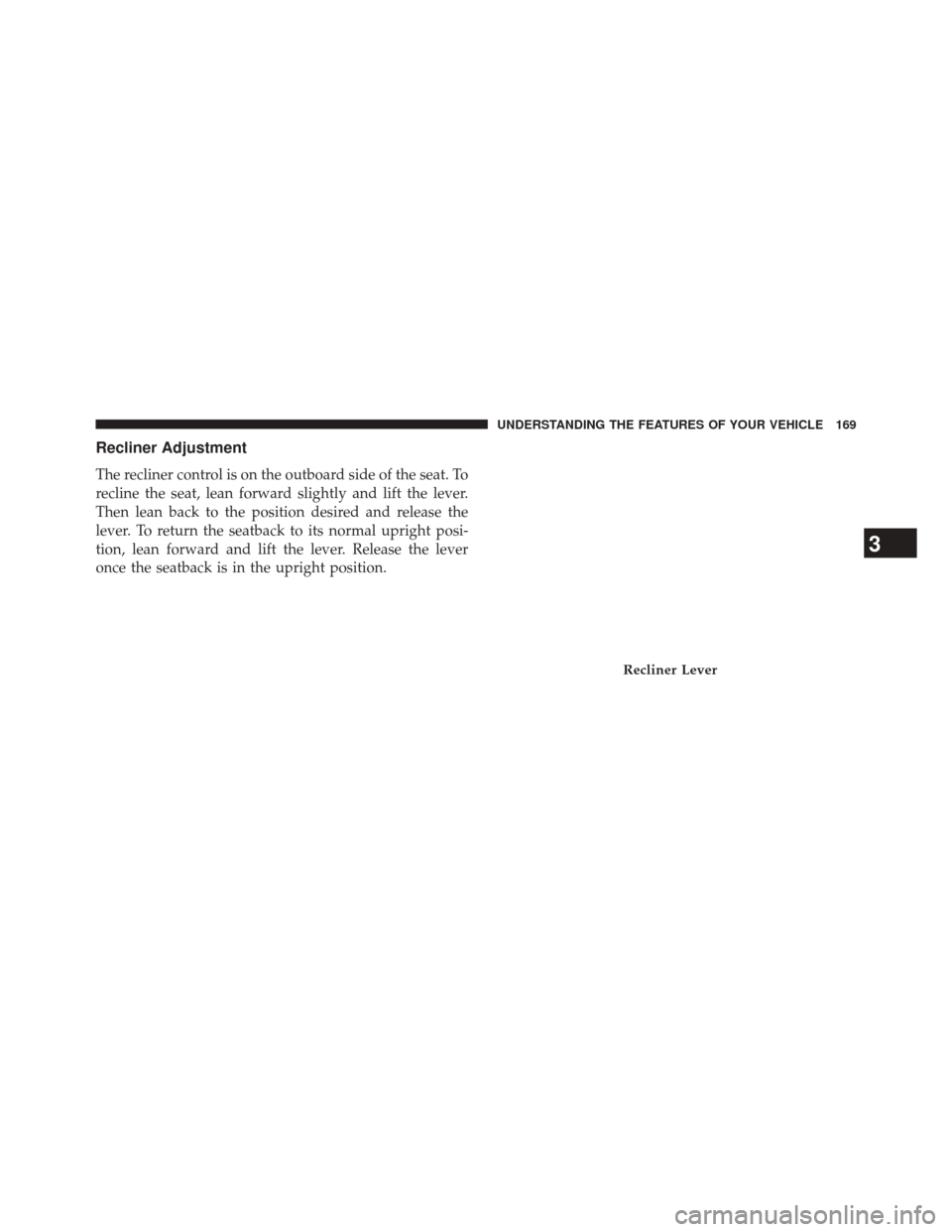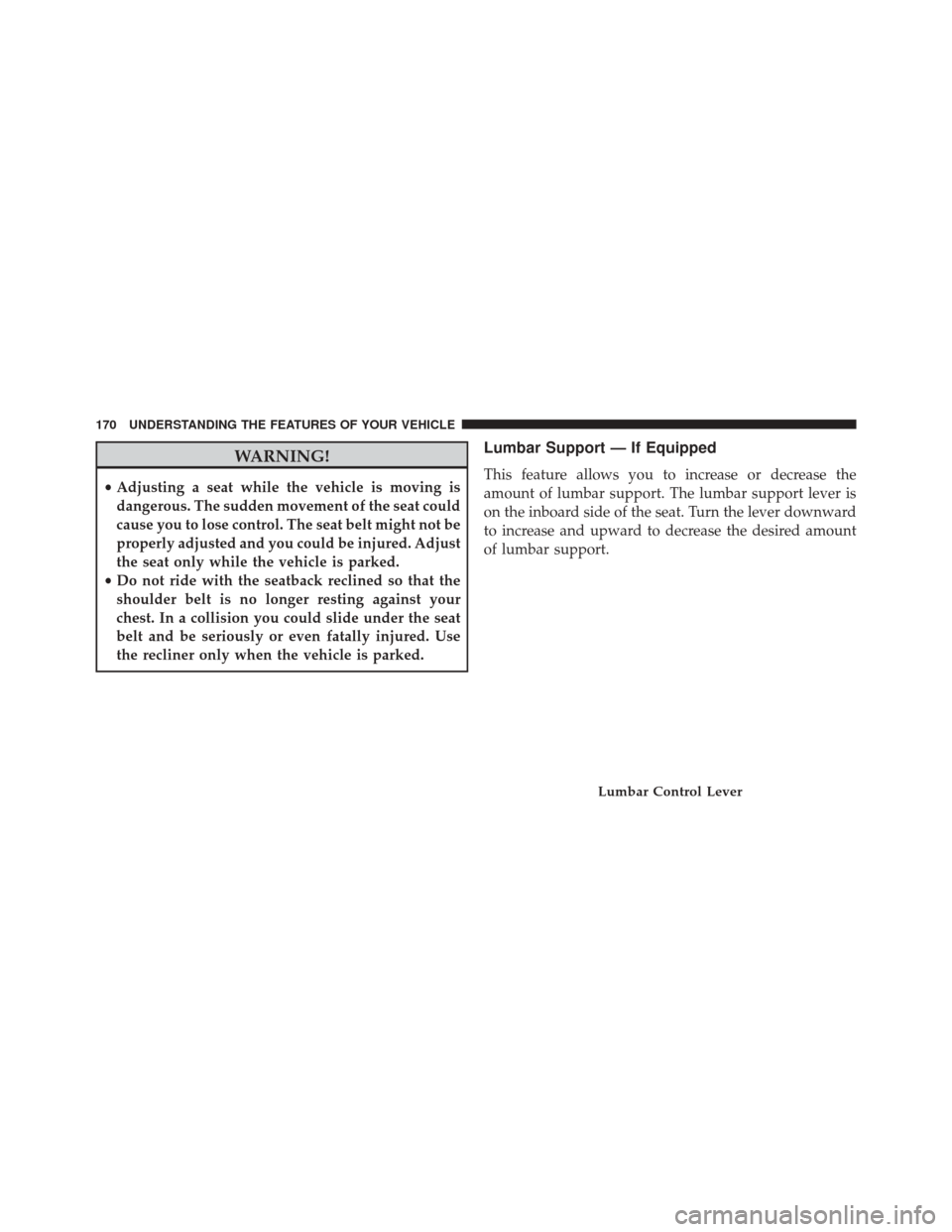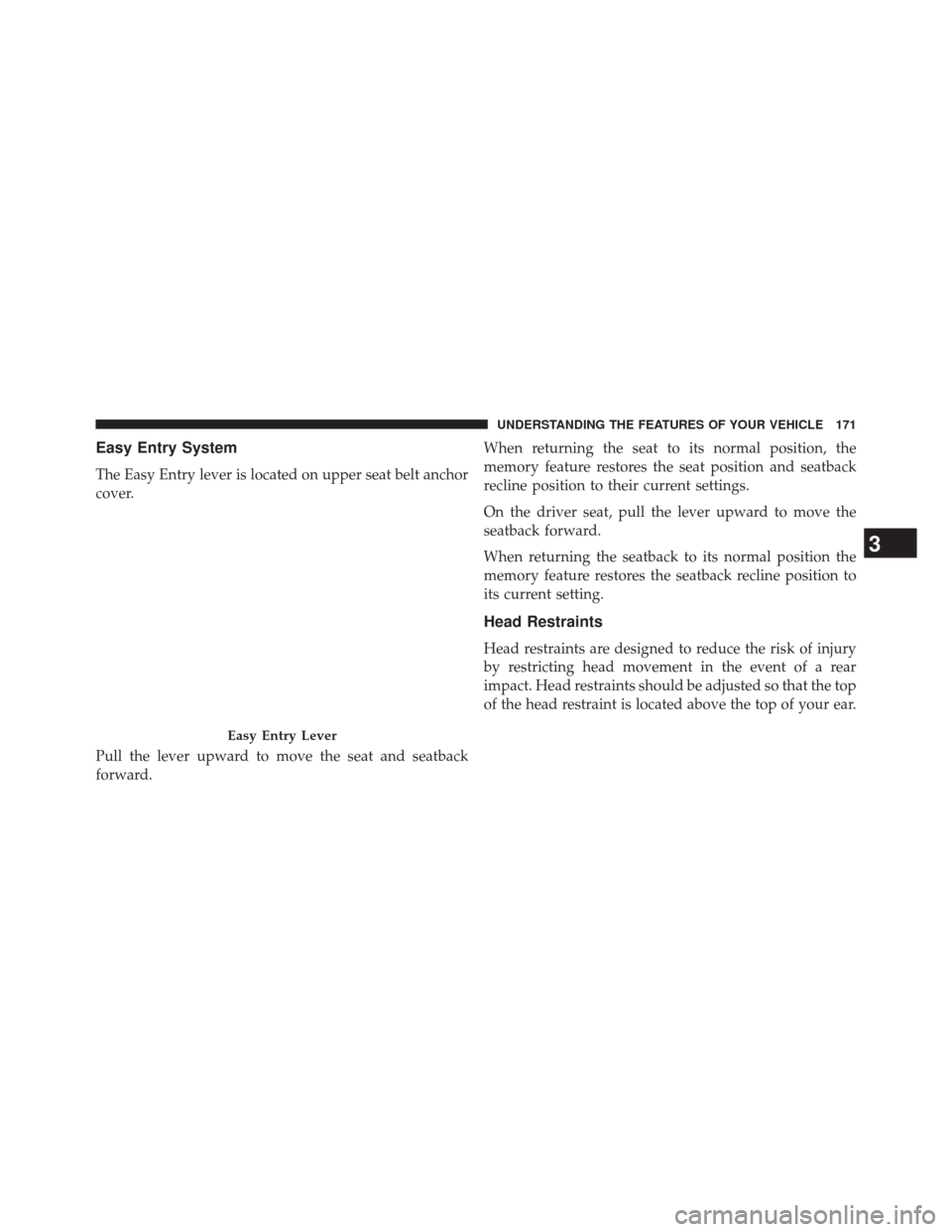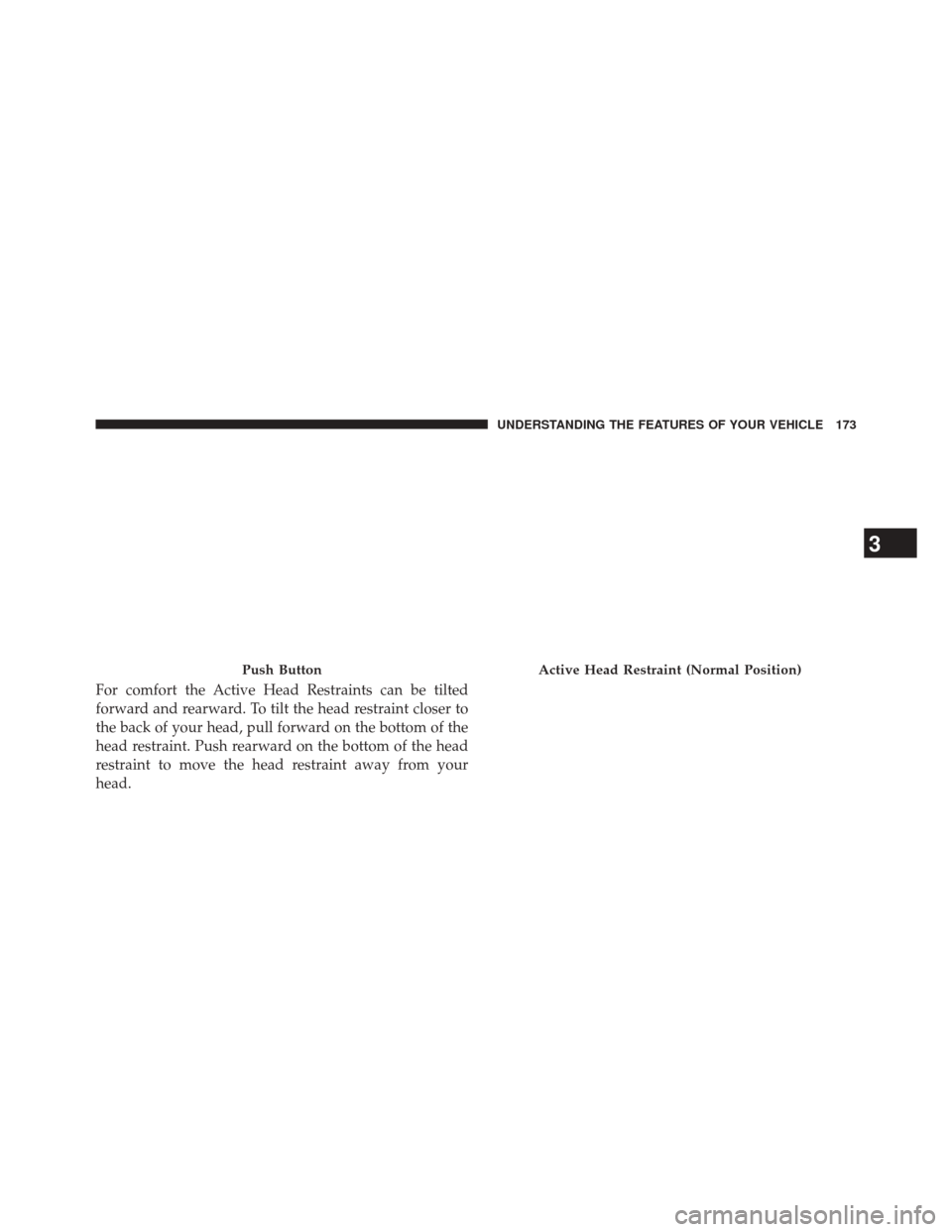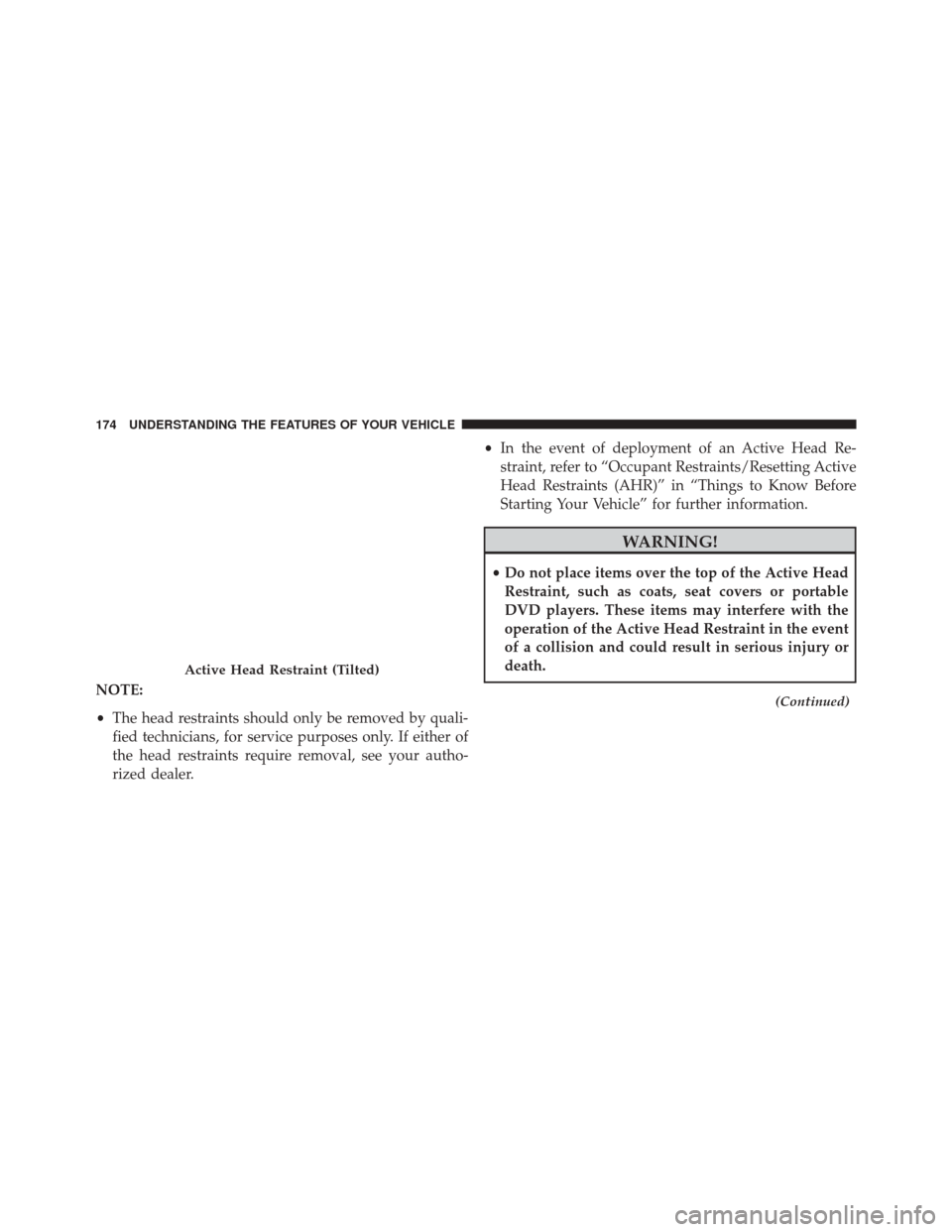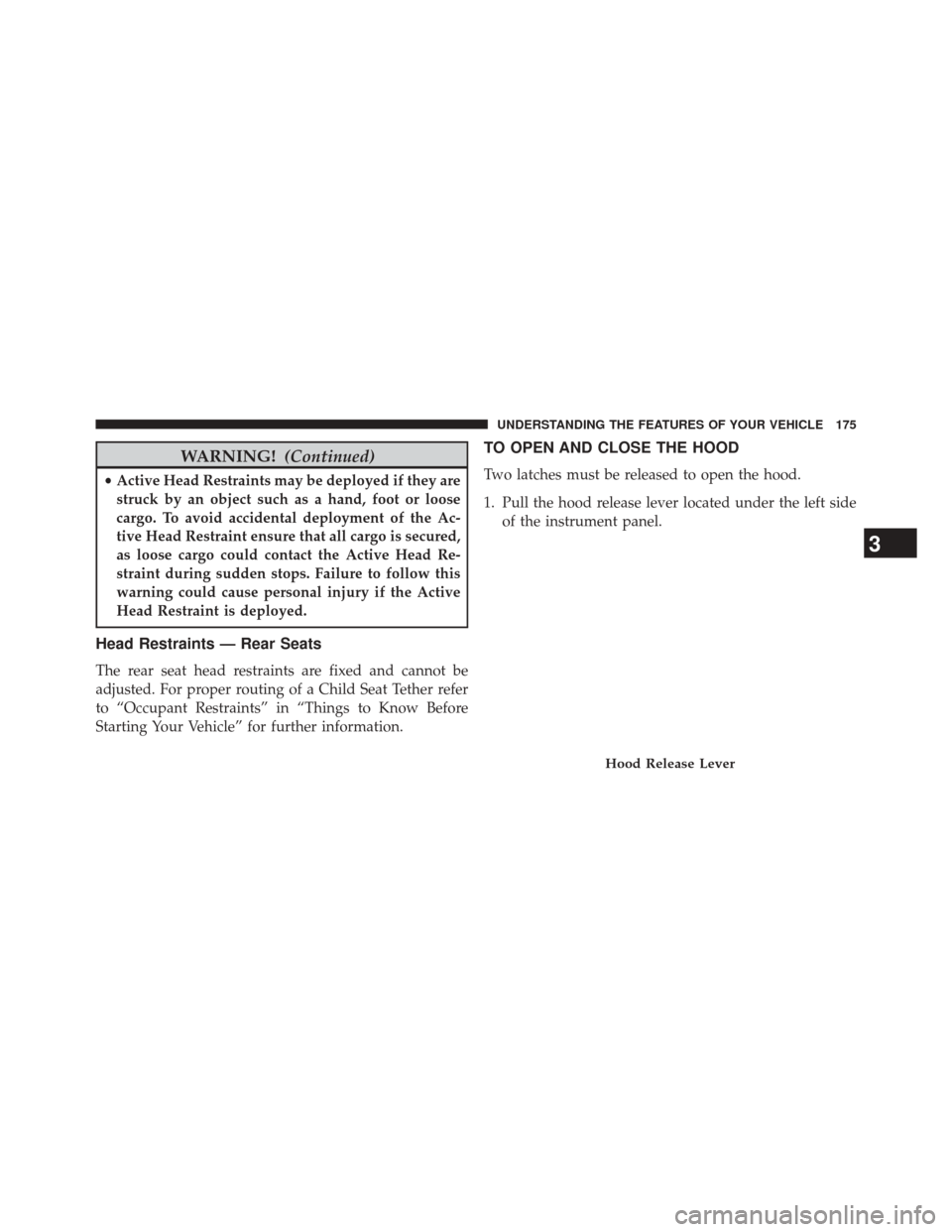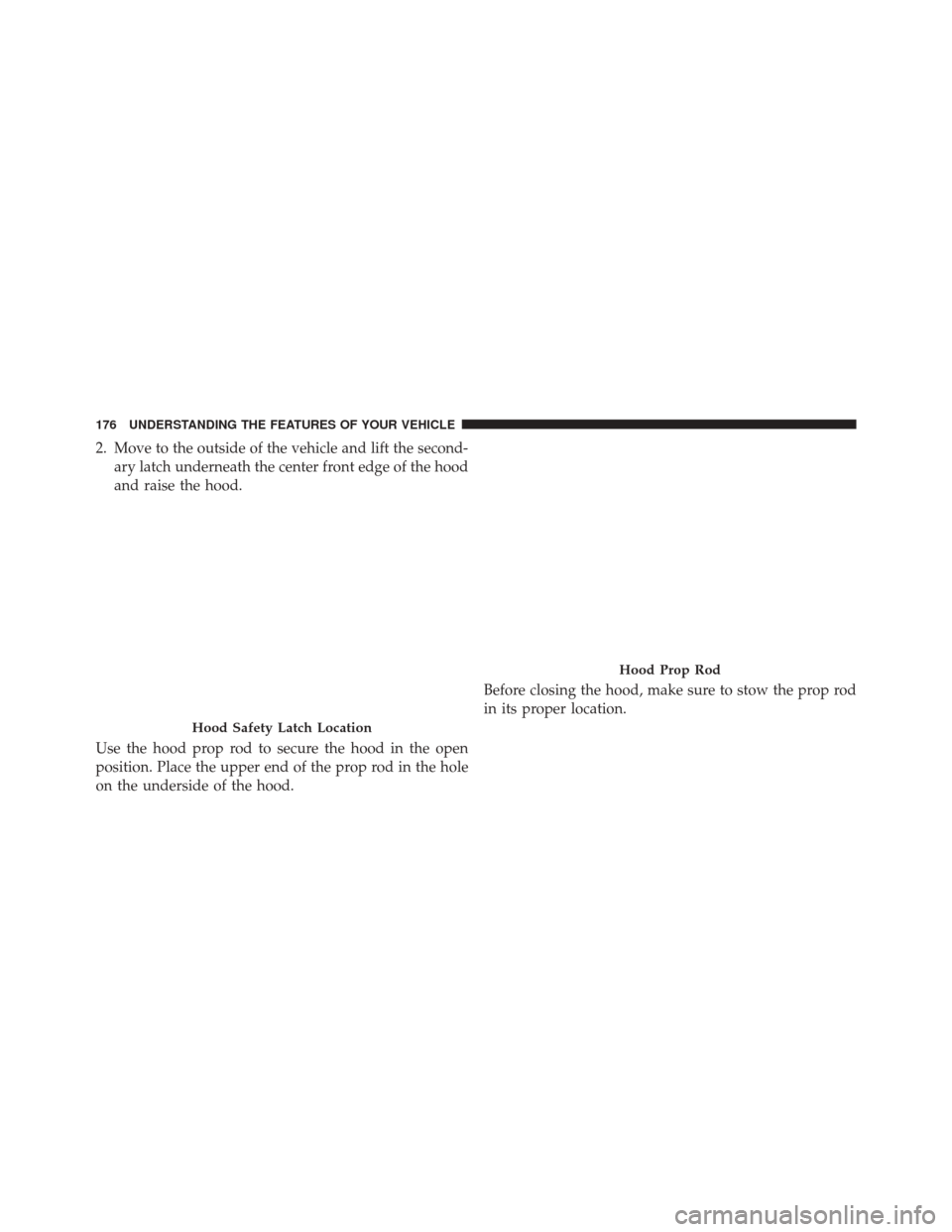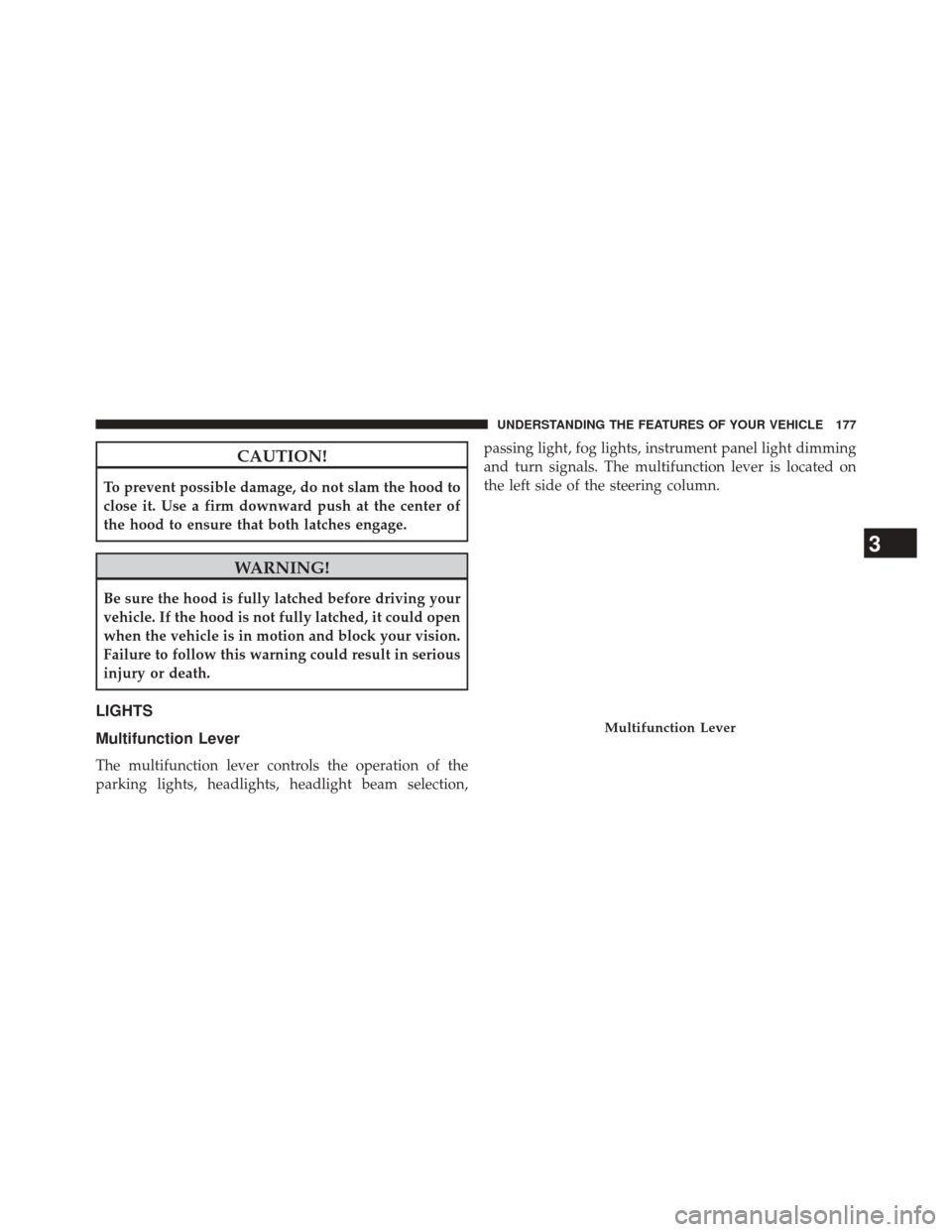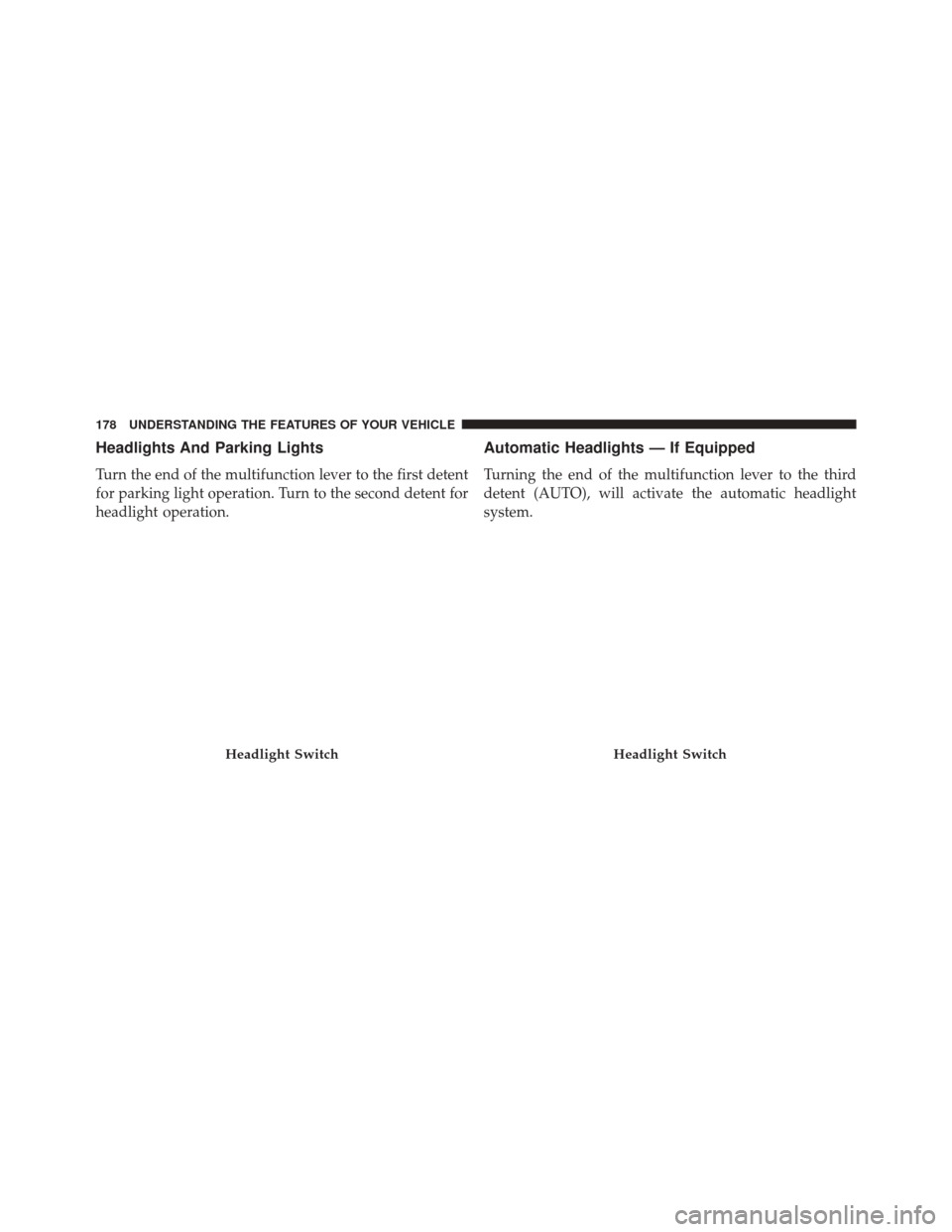CHRYSLER 200 CONVERTIBLE 2014 1.G Owners Manual
200 CONVERTIBLE 2014 1.G
CHRYSLER
CHRYSLER
https://www.carmanualsonline.info/img/25/8450/w960_8450-0.png
CHRYSLER 200 CONVERTIBLE 2014 1.G Owners Manual
Trending: windshield wipers, USB port, engine oil capacity, transmission fluid, jump cable, battery location, child restraint
Page 171 of 522
Recliner Adjustment
The recliner control is on the outboard side of the seat. To
recline the seat, lean forward slightly and lift the lever.
Then lean back to the position desired and release the
lever. To return the seatback to its normal upright posi-
tion, lean forward and lift the lever. Release the lever
once the seatback is in the upright position.
Recliner Lever
3
UNDERSTANDING THE FEATURES OF YOUR VEHICLE 169
Page 172 of 522
WARNING!
•Adjusting a seat while the vehicle is moving is
dangerous. The sudden movement of the seat could
cause you to lose control. The seat belt might not be
properly adjusted and you could be injured. Adjust
the seat only while the vehicle is parked.
• Do not ride with the seatback reclined so that the
shoulder belt is no longer resting against your
chest. In a collision you could slide under the seat
belt and be seriously or even fatally injured. Use
the recliner only when the vehicle is parked.
Lumbar Support — If Equipped
This feature allows you to increase or decrease the
amount of lumbar support. The lumbar support lever is
on the inboard side of the seat. Turn the lever downward
to increase and upward to decrease the desired amount
of lumbar support.
Lumbar Control Lever
170 UNDERSTANDING THE FEATURES OF YOUR VEHICLE
Page 173 of 522
Easy Entry System
The Easy Entry lever is located on upper seat belt anchor
cover.
Pull the lever upward to move the seat and seatback
forward.When returning the seat to its normal position, the
memory feature restores the seat position and seatback
recline position to their current settings.
On the driver seat, pull the lever upward to move the
seatback forward.
When returning the seatback to its normal position the
memory feature restores the seatback recline position to
its current setting.
Head Restraints
Head restraints are designed to reduce the risk of injury
by restricting head movement in the event of a rear
impact. Head restraints should be adjusted so that the top
of the head restraint is located above the top of your ear.
Easy Entry Lever
3
UNDERSTANDING THE FEATURES OF YOUR VEHICLE 171
Page 174 of 522
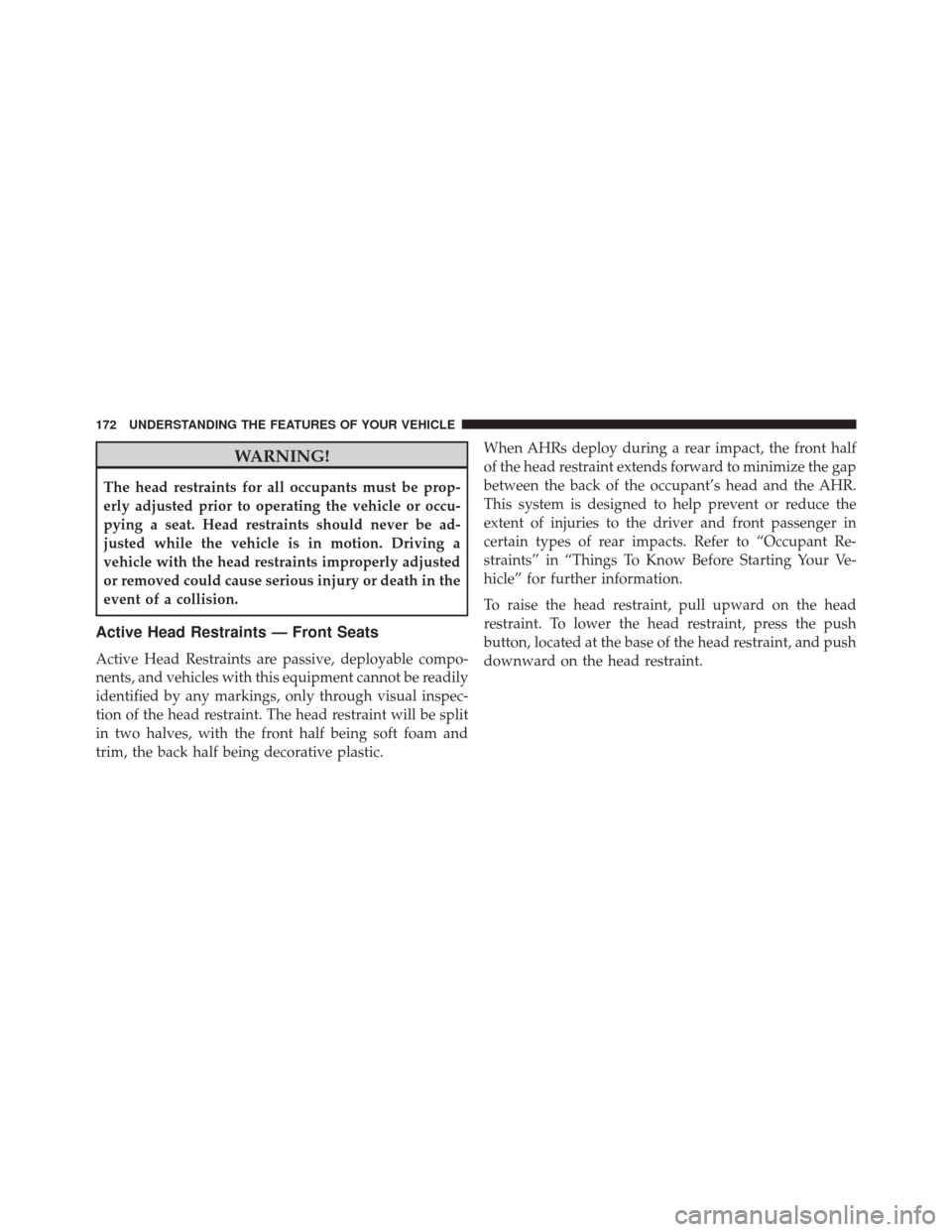
WARNING!
The head restraints for all occupants must be prop-
erly adjusted prior to operating the vehicle or occu-
pying a seat. Head restraints should never be ad-
justed while the vehicle is in motion. Driving a
vehicle with the head restraints improperly adjusted
or removed could cause serious injury or death in the
event of a collision.
Active Head Restraints — Front Seats
Active Head Restraints are passive, deployable compo-
nents, and vehicles with this equipment cannot be readily
identified by any markings, only through visual inspec-
tion of the head restraint. The head restraint will be split
in two halves, with the front half being soft foam and
trim, the back half being decorative plastic.When AHRs deploy during a rear impact, the front half
of the head restraint extends forward to minimize the gap
between the back of the occupant’s head and the AHR.
This system is designed to help prevent or reduce the
extent of injuries to the driver and front passenger in
certain types of rear impacts. Refer to “Occupant Re-
straints” in “Things To Know Before Starting Your Ve-
hicle” for further information.
To raise the head restraint, pull upward on the head
restraint. To lower the head restraint, press the push
button, located at the base of the head restraint, and push
downward on the head restraint.
172 UNDERSTANDING THE FEATURES OF YOUR VEHICLE
Page 175 of 522
For comfort the Active Head Restraints can be tilted
forward and rearward. To tilt the head restraint closer to
the back of your head, pull forward on the bottom of the
head restraint. Push rearward on the bottom of the head
restraint to move the head restraint away from your
head.
Push ButtonActive Head Restraint (Normal Position)
3
UNDERSTANDING THE FEATURES OF YOUR VEHICLE 173
Page 176 of 522
NOTE:
•The head restraints should only be removed by quali-
fied technicians, for service purposes only. If either of
the head restraints require removal, see your autho-
rized dealer. •
In the event of deployment of an Active Head Re-
straint, refer to “Occupant Restraints/Resetting Active
Head Restraints (AHR)” in “Things to Know Before
Starting Your Vehicle” for further information.
WARNING!
• Do not place items over the top of the Active Head
Restraint, such as coats, seat covers or portable
DVD players. These items may interfere with the
operation of the Active Head Restraint in the event
of a collision and could result in serious injury or
death.
(Continued)
Active Head Restraint (Tilted)
174 UNDERSTANDING THE FEATURES OF YOUR VEHICLE
Page 177 of 522
WARNING!(Continued)
•Active Head Restraints may be deployed if they are
struck by an object such as a hand, foot or loose
cargo. To avoid accidental deployment of the Ac-
tive Head Restraint ensure that all cargo is secured,
as loose cargo could contact the Active Head Re-
straint during sudden stops. Failure to follow this
warning could cause personal injury if the Active
Head Restraint is deployed.
Head Restraints — Rear Seats
The rear seat head restraints are fixed and cannot be
adjusted. For proper routing of a Child Seat Tether refer
to “Occupant Restraints” in “Things to Know Before
Starting Your Vehicle” for further information.
TO OPEN AND CLOSE THE HOOD
Two latches must be released to open the hood.
1. Pull the hood release lever located under the left side of the instrument panel.
Hood Release Lever
3
UNDERSTANDING THE FEATURES OF YOUR VEHICLE 175
Page 178 of 522
2. Move to the outside of the vehicle and lift the second-ary latch underneath the center front edge of the hood
and raise the hood.
Use the hood prop rod to secure the hood in the open
position. Place the upper end of the prop rod in the hole
on the underside of the hood. Before closing the hood, make sure to stow the prop rod
in its proper location.
Hood Safety Latch Location
Hood Prop Rod
176 UNDERSTANDING THE FEATURES OF YOUR VEHICLE
Page 179 of 522
CAUTION!
To prevent possible damage, do not slam the hood to
close it. Use a firm downward push at the center of
the hood to ensure that both latches engage.
WARNING!
Be sure the hood is fully latched before driving your
vehicle. If the hood is not fully latched, it could open
when the vehicle is in motion and block your vision.
Failure to follow this warning could result in serious
injury or death.
LIGHTS
Multifunction Lever
The multifunction lever controls the operation of the
parking lights, headlights, headlight beam selection,passing light, fog lights, instrument panel light dimming
and turn signals. The multifunction lever is located on
the left side of the steering column.
Multifunction Lever
3
UNDERSTANDING THE FEATURES OF YOUR VEHICLE 177
Page 180 of 522
Headlights And Parking Lights
Turn the end of the multifunction lever to the first detent
for parking light operation. Turn to the second detent for
headlight operation.
Automatic Headlights — If Equipped
Turning the end of the multifunction lever to the third
detent (AUTO), will activate the automatic headlight
system.
Headlight SwitchHeadlight Switch
178 UNDERSTANDING THE FEATURES OF YOUR VEHICLE
Trending: diagram, hood release, engine oil, service, fuel tank capacity, check oil, coolant capacity
